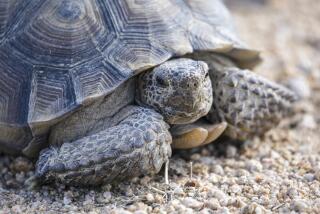Park Service Moves to Limit Grazing on Santa Rosa : Environment: State ruling could lead to halting cattle ranching on the island in effort to protect rare plants.
Preparing to clean up polluted streams and protect rare plants, the National Park Service proposes closing one-fifth of Santa Rosa Island to cattle grazing next spring and is devising long-term environmental plans that could drive a historic cattle ranch off the island.
Officials with the Park Service, which bought the island from a ranching family nearly a decade ago, said they may have to cut short the family’s quarter-century ranching permit because of rare plants found on the island and because of a ruling by state water quality officials.
Under an order from the State Water Resources Control Board, park officials must draft short- and long-term management plans to reduce the cattle’s impact on streams and other habitat for native plants.
“There is very little evidence that the existing cattle ranch is forcing these species into oblivion, yet this order has the force of law,” said Tim Setnicka, assistant superintendent of the Channel Islands National Park. “The order could force the Park Service to terminate ranching on the island.”
Beginning this week, park officials will host a series of public workshops on the plan for the island, which lies 30 miles off the Santa Barbara coast.
The Park Service’s action comes after months of pressure from conservation groups to limit the island’s hunting and ranching operations.
The National Parks and Conservation Assn., a group dedicated to protecting parklands, has threatened to sue the Park Service over allegations that it has failed its mandate to preserve the island’s natural resources.
The association has decided to hold off on its lawsuit, pending the success of the Park Service’s plans to reduce or eliminate the herds of cattle, elk and deer now on the island, said Brian Huse, the association’s Pacific regional director.
“The park was not set aside as a cattle ranch,” Huse said. “The government paid an amazing amount of money for the land and grazing rights. That gives them the right to exert some management control.”
Neil Levin, an attorney with the Environmental Defense Center in Santa Barbara, said the park’s founding legislation compels officials to protect the park’s native plants from non-native animals. “The problem is not just the cattle,” he said. “The deer can get to places where the cattle can’t.”
Park officials have been reluctant to interfere with the Vail & Vickers Co. cattle ranching operation, which has been using grasslands on the 84-square-mile island to fatten cattle since 1902.
The family-owned company has about 6,500 head of cattle, an estimated 800 elk and 640 deer on the island. The family charges hunters a fee to stalk the elk and deer.
The Park Service bought the land from Vail & Vickers in 1986 for $30 million, on the condition that the company be allowed to continue ranching for 25 years--unless the operations are incompatible with the preservation of the island’s natural resources.
Setnicka said the Park Service is caught in the middle, trying to uphold its agreement with Vail & Vickers while fending off complaints from conservation groups and environmental attorneys.
“The chorus of complaints is rising louder to get ranching off of the island,” he said.
Park officials are also working closely with their counterparts in the U.S. Fish and Wildlife Service to preserve habitat for a variety of rare plant species on the island.
In July, fish and wildlife officials proposed that 16 rare plants found on the northern Channel Islands be added to the nation’s list of endangered species.
Ten species--including the soft-leaved Indian paintbrush, the munchkin dudleya and Hoffmann’s gilia--are found on Santa Rosa Island.
The Park Service installed a $10,000 electric fence to keep cattle away from three of the rare plants. And its state-ordered environmental management plans will include strategies to protect the plants from extinction.
Setnicka said a draft of the short-term plan should be available in a few weeks and must be finalized by Jan. 1. Under this plan, the Park Service wants to close two large pastures to grazing for two years. This pastureland makes up about 20% of the island’s 54,000 acres.
After the two-year recovery period, the Park Service would allow the ranchers to graze cattle on those pastures during the cool or winter months only.
As for long-term environmental plans, Setnicka said they are just getting under way and the Park Service will solicit suggestions at its upcoming public workshops. The long-term plan must be submitted to state water officials by June.
“One of the options has to be to immediately eliminate the grazing operation,” Setnicka said. Hopefully, he said, the plans can avoid infringing on the agreement with Vail & Vickers or economically harming the last ranching operation on the Channel Islands.
Setnicka said he fears that conservative members of Congress will seize on the Santa Rosa Island case as an example to help them gut the Endangered Species Act and other environmental laws.
“This has become a textbook case [for] certain members of Congress to point their fingers to abuse of authority, too much federal regulation, and a lack of sensitivity to the rights of private parties,” he said.
More to Read
Sign up for Essential California
The most important California stories and recommendations in your inbox every morning.
You may occasionally receive promotional content from the Los Angeles Times.










